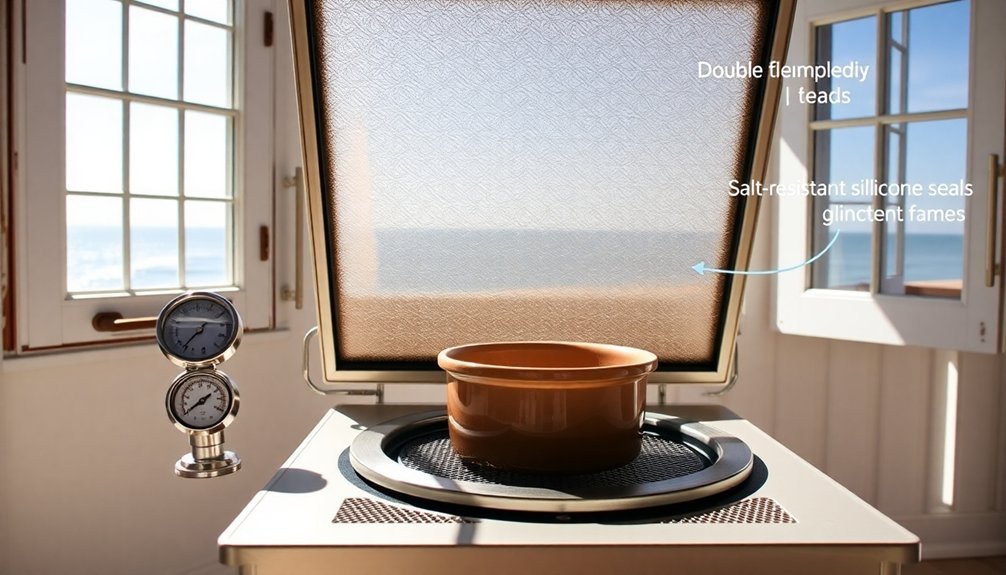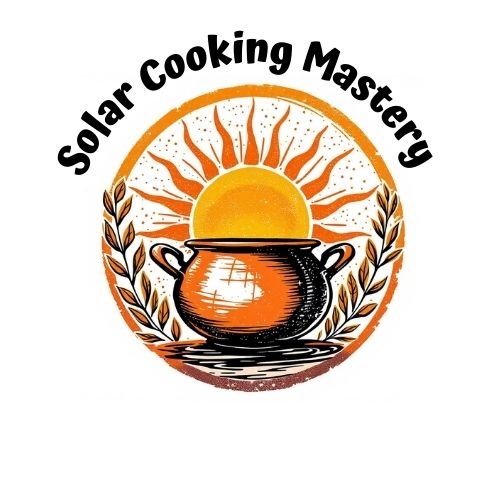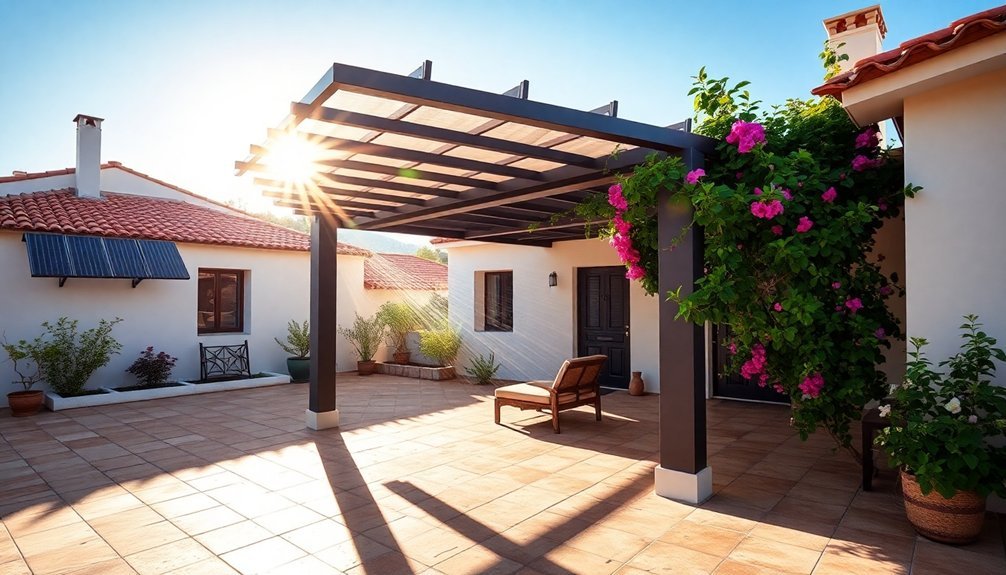Position your solar cooking setup in a flat, open area that maximizes coastal sunlight from 11 AM to 3 PM for ideal results. You'll want to scout locations with minimal shadows and take advantage of natural reflective surfaces like sand and water. Keep your ingredients beach-friendly by choosing items that withstand outdoor temperatures, and store them properly in airtight containers with ice packs. Monitor weather conditions closely using apps like FEMA Mobile and NOAA Weather Radio, and protect your equipment from salt air and moisture. Set up proper drainage and ventilation systems to control humidity. These coastal solar cooking basics will set the foundation for your sun-powered culinary adventures.
Finding Your Perfect Sunny Spot

Where you position your solar oven can make or break your cooking success, especially in a coastal environment.
You'll want to scout your property for the flattest, most open area that gets consistent sunlight throughout the day. Look for spots away from buildings, trees, and fences that could cast unwanted shadows.
If you're near the beach, take advantage of natural reflective surfaces like sand and water to enhance your oven's performance. Make sure to adjust the oven periodically throughout your cooking time to track the sun's path.
Position your cooker where you can easily adjust its direction and tilt as the sun moves across the sky. Keep an eye on coastal features like cliffs or ridges that might block sunlight during certain hours.
Remember to check your chosen location with a thermometer to confirm it maintains adequate cooking temperatures, and verify the ground is stable enough to prevent any wobbling.
Timing Your Solar Meals
When you're cooking with solar power along the coast, timing is everything. You'll want to maximize your cooking between 11 AM and 3 PM when the sun's rays are strongest.
During summer, you've got extended hours from 10 AM to 4 PM, while winter limits you to a tighter window between 11:30 AM and 2:30 PM.
To make the most of your solar cooking time, pre-heat your oven for 15-20 minutes before adding food. Use dark, thin-metal cookware with lids to absorb heat efficiently. Place ingredients in shallow aluminum vessels for optimal heat distribution.
If you're planning a larger meal, consider starting early and keeping dishes warm until serving time. During shorter winter days, you might need to split cooking over two days.
Remember to position your solar oven facing south and monitor internal temperatures, especially when cooking meat.
Adapting Beach Recipes

Adapting recipes for beach solar cooking requires smart ingredient choices and careful planning.
You'll want to select ingredients that can withstand outdoor temperatures while maintaining their quality, like prosciutto, cheese, and fresh seasonal fruits. Choose hydrating options such as watermelon, cantaloupe, and cucumbers to combat the beach heat.
Prep your dishes in advance to maximize beach cooking success. Make components like avocado hummus the night before, and plan meals that can be quickly assembled on-site. Pinwheel sandwiches made with rolled tortilla spirals are excellent make-ahead options that transport well.
Pack your ingredients in airtight, leak-proof containers and use coolers with ice packs to maintain freshness. Keep your food shaded from direct sunlight and opt for room temperature-friendly recipes like panzanella salad or summer couscous.
Remember to bring serving utensils that are easy to clean and maintain in a beach environment.
Weather Watch Strategies
Successful solar cooking at the beach hinges on your ability to track and respond to weather conditions. You'll need to stay informed through multiple channels, including the FEMA Mobile App, NOAA Weather Radio, and local news updates.
| Weather Factor | What to Watch | Action Needed |
|---|---|---|
| Sea Breeze | 2-5°F land-sea difference | Adjust solar cooker angle |
| Storm Threats | Hurricane/nor'easter warnings | Pack up immediately |
| Wind Changes | Local geography impacts | Secure equipment |
Don't rely on a single source for weather information – layer your awareness using mobile apps, weather radio, and local forecasts. When coastal storms threaten, follow public safety instructions immediately. Keep your car fueled up and maintain an emergency kit nearby. Remember that coastal weather can change rapidly, so you'll need to stay vigilant and ready to adapt your solar cooking plans accordingly.
Moisture Control Methods

Proper moisture control stands as a critical foundation for effective solar cooking in coastal environments. You'll need to focus on both your cooking space and storage areas to maintain ideal conditions.
Start by selecting moisture-resistant materials for your kitchen setup. Choose treated wood or stone countertops, and install proper ventilation systems with dehumidifiers to keep your cooking area dry.
Don't forget to use closed-cell foam insulation in your kitchen walls to prevent humidity buildup.
Make sure you've got efficient drainage systems in place, particularly around your outdoor solar cooking station. Install moisture barriers and maintain proper slopes to direct water away from your cooking area.
Consider adding coastal-friendly plants nearby to help absorb excess moisture, and position your solar cooking station where natural airflow can help manage humidity levels.
Seasonal Position Adjustments
As the Earth's position relative to the sun shifts throughout the year, you'll need to adjust your solar oven's placement to maintain peak cooking efficiency.
During summer months, position your oven to capture the intense sunlight between 11 AM and 3 PM, when the sun is highest. Use dark cookware to maximize heat absorption.
In spring and fall, you'll want to optimize for mid-morning to late afternoon exposure, adjusting the angle to accommodate the lower sun position.
Add reflectors to enhance sunlight capture during these changing seasons.
Winter requires the most adaptation. Set your oven to catch low-angle sunlight, and expect longer cooking times.
You'll benefit from additional reflectors and should choose recipes that work well with extended, slower cooking periods.
Salt Air Protection

Living near the coast requires robust protection for your solar oven against corrosive salt air.
You'll need to pressure wash your solar cooker's exterior components annually using a gentle setting to prevent damage. Apply anti-corrosion coatings and high-quality sealants to protect metal parts and joints from salt exposure.
Store your solar oven in a covered area when not in use, and inspect it regularly for signs of salt damage or corrosion.
If your oven has removable parts, bring them indoors after each use. Choose stainless steel or galvanized components when replacing hardware, as they're more resistant to salt air damage.
Seal any cracks or gaps immediately to prevent moisture infiltration, and clean the glass surfaces frequently to maintain peak cooking efficiency.
Consider installing a protective cover during severe weather events.
Frequently Asked Questions
Can I Use Aluminum Foil to Enhance Solar Cooking Performance?
Yes, you can line your solar cooker with aluminum foil to dramatically boost performance. It'll reflect up to 95% of sunlight into your cooking area, though you'll need to replace it periodically as it fades.
How Do Marine Birds Affect Solar Oven Cooking on Boats?
You don't need to worry about marine birds affecting your solar oven cooking on boats. They won't impact your cooking performance. Focus instead on positioning your oven for maximum sunlight and managing weather conditions.
What Happens if I Accidentally Leave Food in Overnight?
You'll need to throw away any food left out overnight. It's not safe to eat due to bacterial growth and heat-resistant toxins that can cause severe illness, even if you reheat it thoroughly.
Does Sand Buildup Impact the Effectiveness of Reflective Surfaces?
Yes, sand buildup considerably reduces your reflective surfaces' effectiveness. You'll lose up to 9.4% average reflectivity, and in some cases, heavy deposits can decrease performance by up to 39% within two weeks.
Can Multiple Small Ovens Cook Faster Than One Large One?
Yes, you'll find that multiple small ovens cook faster than one large oven. They heat up more quickly, requiring less preheating time, and let you cook different dishes simultaneously at their ideal temperatures.
In Summary
You'll master solar cooking at the coast by following these essential strategies. From positioning your cooker for ideal sunlight to protecting it from corrosive salt air, you're now equipped to harness the sun's power while enjoying beach living. Remember to adjust for seasonal changes, monitor weather patterns, and keep moisture at bay. With these tips, you'll create delicious solar-cooked meals in your coastal paradise.





Leave a Reply